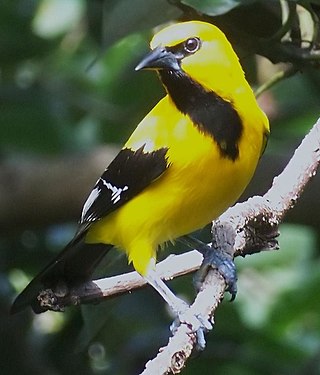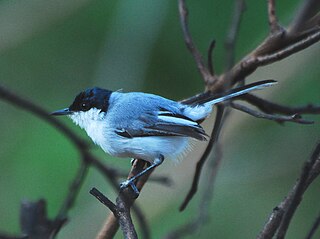
The Eurasian golden oriole, also called the common golden oriole, is the only member of the Old World oriole family of passerine birds breeding in Northern Hemisphere temperate regions. It is a summer migrant in Europe and Palearctic and spends the winter season in central and southern Africa.

The olive-backed oriole, or white-bellied oriole, is a very common medium-sized passerine bird native to northern and eastern Australia and south-central New Guinea. The most wide-ranging of the Australasian orioles, it is noisy and conspicuous.

The African golden oriole, or African oriole, is a member of the oriole family of passerine birds which is a resident breeder in Africa south of the Sahara desert.

The black-hooded oriole is a member of the oriole family of passerine birds and is a resident breeder in tropical southern Asia from India and Sri Lanka east to Indonesia.

The yellow oriole is a passerine bird in the family Icteridae. It should not be confused with the green oriole, sometimes alternatively called the Australasian yellow oriole, which is an Old World oriole.

The Isabela oriole is a species of the oriole family endemic to Luzon in the Philippines. The bird was presumed to be extinct for many years until its rediscovery in December 1993 near Diffun, Quirino, and in Mansarong in September 1994. Additional sightings were made in San Mariano, Isabela. and Baggao, Cagayan Valley It It is found in moist lowland forest up to 440 masl. It is threatened by habitat loss and hunting.

The black-eared oriole, or Buru oriole, is a species of bird in the family Oriolidae. It is native to Buru island.

The western oriole, or western black-headed oriole, is a species of bird in the family Oriolidae that is native to Africa. The adult upperparts are yellow-olive, and the underparts are yellow in colour. It is rated as a species of least concern on the International Union for Conservation of Nature Red List of Endangered Species.

The green-headed oriole, or montane oriole, is a species of bird in the family Oriolidae. It is found in eastern Africa.

The São Tomé oriole, or great-billed oriole, is a species of bird in the family Oriolidae. The species was named by Gustav Hartlaub in 1857. It is endemic to the island of São Tomé. Its natural habitats are subtropical or tropical moist lowland forests and subtropical or tropical moist montane forests. It is threatened by habitat loss.

The grey-collared oriole, or Seram oriole, is a species of bird in the family Oriolidae. It is endemic to Seram.

The black-winged oriole is a species of bird in the family Oriolidae. It is found in Africa from Sierra Leone and Liberia to southern South Sudan, western Uganda, central Democratic Republic of Congo and north-western Angola.
The mountain oriole is a bird species in the family Oriolidae. It is found in central and eastern Africa, from the eastern Democratic Republic of Congo to central Kenya and western Tanzania. Its natural habitats are subtropical or tropical moist montane forests.
The dusky-brown oriole is a species of bird in the family Oriolidae. It is endemic to North Maluku.

The Philippine oriole or grey-throated oriole is a species of bird in the family Oriolidae. It is endemic to the Philippines.

The brown oriole is a species of bird in the family Oriolidae.

The maroon oriole is a species of bird in the family Oriolidae. It is found in Southeast Asia.

The dark-throated oriole is a species of bird in the family Oriolidae.

The white-lored gnatcatcher is a species of bird in the family Polioptilidae. It is found in Costa Rica, El Salvador, Guatemala, Honduras, Mexico, and Nicaragua.

The Indian golden oriole is a species of oriole found in the Indian subcontinent and Central Asia. The species was formerly considered to be a subspecies of the Eurasian golden oriole, but is now considered a full species. Adults can be told apart from the Eurasian golden oriole by the black of the eye stripe extending behind the eye.



















